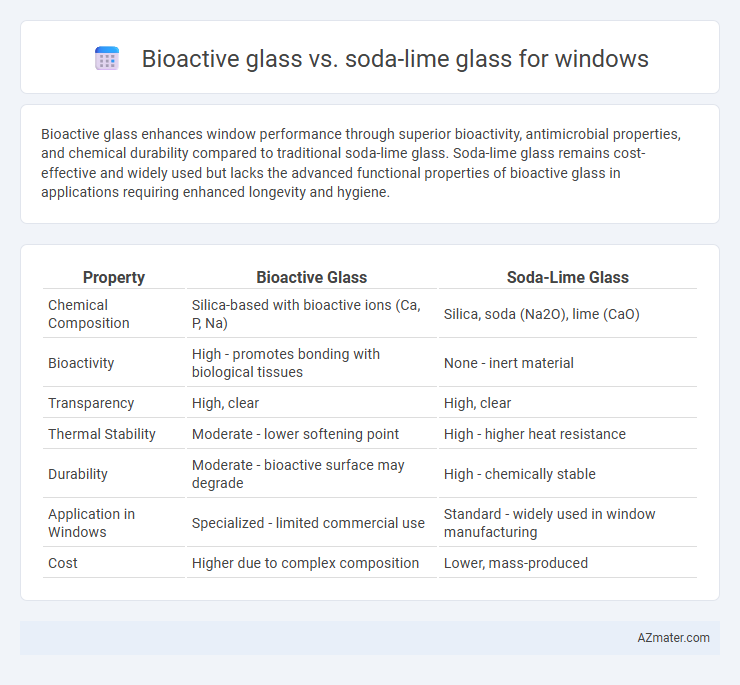Bioactive glass enhances window performance through superior bioactivity, antimicrobial properties, and chemical durability compared to traditional soda-lime glass. Soda-lime glass remains cost-effective and widely used but lacks the advanced functional properties of bioactive glass in applications requiring enhanced longevity and hygiene.
Table of Comparison
| Property | Bioactive Glass | Soda-Lime Glass |
|---|---|---|
| Chemical Composition | Silica-based with bioactive ions (Ca, P, Na) | Silica, soda (Na2O), lime (CaO) |
| Bioactivity | High - promotes bonding with biological tissues | None - inert material |
| Transparency | High, clear | High, clear |
| Thermal Stability | Moderate - lower softening point | High - higher heat resistance |
| Durability | Moderate - bioactive surface may degrade | High - chemically stable |
| Application in Windows | Specialized - limited commercial use | Standard - widely used in window manufacturing |
| Cost | Higher due to complex composition | Lower, mass-produced |
Introduction to Glass Types: Bioactive vs Soda-Lime
Bioactive glass is a specialized material known for its regenerative properties and biocompatibility, often used in medical and dental applications, whereas soda-lime glass is the most common type of glass used in windows due to its cost-effectiveness and durability. Soda-lime glass is primarily composed of silica, soda, and lime, providing excellent transparency and structural integrity, while bioactive glass contains silica, calcium oxide, and phosphorus pentoxide, promoting interaction with biological tissues. For window applications, soda-lime glass remains the preferred choice for its stability and ease of manufacture, whereas bioactive glass is less common and typically reserved for niche, functional uses.
Chemical Composition Differences
Bioactive glass primarily consists of silica (SiO2), calcium oxide (CaO), sodium oxide (Na2O), and phosphorus pentoxide (P2O5), designed to interact with biological tissues through controlled ion release. Soda-lime glass, the standard for windows, mainly contains silicon dioxide (around 70-74%), sodium oxide (12-16%), and calcium oxide (5-11%), providing chemical stability and durability but lacking bioactivity. The distinct presence of phosphorus pentoxide and the balanced calcium-to-sodium ratio in bioactive glass contribute to its ability to bond with living tissues, unlike soda-lime glass's inert chemical structure.
Manufacturing Processes of Both Glass Types
Bioactive glass manufacturing involves sol-gel or melt-quenching methods, where precise control of composition and temperature enables enhanced bioactivity and ion release properties. Soda-lime glass production uses a traditional batch melting process at approximately 1400-1600degC, followed by forming techniques like floating or rolling to achieve uniform window panes. The sol-gel process for bioactive glass allows molecular-level homogeneity, unlike the large-scale industrial melting and forming methods used for soda-lime glass, impacting their structural and functional characteristics for window applications.
Mechanical Strength and Durability
Bioactive glass exhibits superior mechanical strength and enhanced durability compared to soda-lime glass, making it more resistant to scratches, impacts, and environmental wear. The unique composition of bioactive glass allows it to maintain structural integrity under stress and resist chemical degradation over time. In contrast, soda-lime glass, while cost-effective, is more prone to breakage and surface damage due to lower tensile strength and susceptibility to weathering.
Optical Clarity and Light Transmission
Bioactive glass exhibits superior optical clarity and higher light transmission compared to soda-lime glass, making it ideal for window applications requiring enhanced visibility. Its unique composition allows for minimal light scattering and reduced haze, optimizing natural light passage while maintaining structural integrity. In contrast, soda-lime glass typically has lower transparency levels due to impurities and a higher refractive index, which can reduce overall light transmission.
Thermal Properties and Insulation
Bioactive glass exhibits superior thermal insulation compared to soda-lime glass due to its lower thermal conductivity and enhanced heat retention capabilities. The unique composition of bioactive glass allows it to maintain structural integrity at higher temperatures while providing effective thermal barriers, reducing energy loss in window applications. In contrast, soda-lime glass, commonly used in windows, has higher thermal conductivity, resulting in less efficient insulation and greater heat transfer.
Environmental Impact and Sustainability
Bioactive glass exhibits superior environmental benefits compared to soda-lime glass due to its enhanced recyclability and ability to support natural biogeochemical cycles through ion release. Soda-lime glass, while widely used, requires high energy consumption during manufacturing and has limited biodegradability, resulting in greater environmental burden. The sustainability of bioactive glass is further reinforced by its reduced carbon footprint and potential for integration in eco-friendly building materials.
Cost Analysis and Market Availability
Bioactive glass, known for its superior biocompatibility and antibacterial properties, is significantly more expensive than traditional soda-lime glass, primarily due to its complex manufacturing process and specialized raw materials. Soda-lime glass dominates the window market with extensive availability and cost efficiency, benefiting from mass production and established supply chains worldwide. The higher production costs and limited suppliers of bioactive glass restrict its widespread market adoption compared to the highly accessible and affordable soda-lime glass.
Suitability for Architectural Applications
Bioactive glass offers superior durability, chemical resistance, and bio-inert properties compared to soda-lime glass, making it highly suitable for innovative architectural applications where longevity and safety are paramount. Its unique composition allows for enhanced thermal insulation and resistance to environmental degradation, which is critical in modern building facades and energy-efficient windows. In contrast, soda-lime glass, while cost-effective and widely used, lacks the advanced performance characteristics required for high-end architectural uses, limiting its suitability in environments demanding long-term structural integrity and sustainability.
Future Prospects and Innovations in Window Glass
Bioactive glass offers promising future prospects for window technology due to its enhanced durability, self-cleaning properties, and ability to support indoor air quality by releasing beneficial ions. Innovations in soda-lime glass focus on improving energy efficiency through advanced coatings and incorporating smart technologies such as electrochromic and photovoltaic capabilities. Combining the bioactivity of bioactive glass with the affordability and adaptability of soda-lime glass could revolutionize sustainable and multifunctional window solutions for smart buildings.

Infographic: Bioactive glass vs Soda-lime glass for Window
 azmater.com
azmater.com